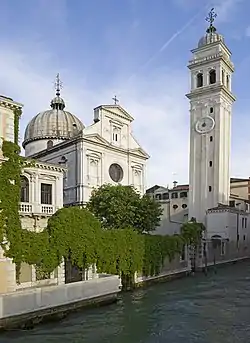Scuola dei Greci
The Scuola dei Greci (known as The Greek Brotherhood of Venice) was the cultural and religious center of the Greek community in Venice.
Scuola dei Greci | |
 The Church of San Giorgio dei Greci, Venice | |
| Formation | November 1494 |
|---|---|
| Founder | Greek community in Venice |
| Dissolved | 1806 |
| Type | Confraternity |
| Location | |
Official language | Greek |
The Venetian Scuole were confraternities formed by ethnic or religious groups that lived in the city during the Renaissance. They provided an environment for the social, cultural and religious activities of their members. The Greek minority was present in Venice as early as the 13th century, but increased greatly in the 15th and 16th centuries after the Fall of Constantinople and the Ottoman expansion into the former Byzantine lands.
On November 28, 1494, the Greeks received permission to establish a "Scuola e Nazione greca," one of the "Scuole Piccole" and "Scuole Nazionali" of Venice.[1] Initially there was a stipulation that membership should not exceed 250 persons (despite there being a Greek quarter in the city with a population of over 4000), apart from women and children. The Scuola had a constitution with provisions for voting procedures, representation, and the formation of a council. In 1563 the number of the councillors, the governing body of the colony, was set at forty and was later increased. The officials, headed by a president Gastaldo, were salaried by the community but were under the supervision of the Venetian government. The success of the Greek community in securing formal recognition from the Venetian government was probably due in large part to the increasing dependence of the Venetian state on the military services of the Stratioti.[2]
The Greeks initially used Catholic churches for their gatherings until Venice granted them permission to settle permanently and build in the Castello area in 1456. The Greek community was well accepted by the city largely because of the education and the ideas they brought. in 1539 they were allowed by the Venetian government to build a Greek Orthodox church, the church of San Giorgio dei Greci and formed the Scuola di San Nicolo dei Greci (or Scuola dei Greci), as well as the Flanginian School. This Scuola was one of the few Venetian Scuole around which an entire community developed. Around the Church of San Giorgio other buildings and rooms were built for the meetings of the Confraternity.[3]
The Scuola had a central role in the development of Venetian and Italian typography. Among the members of the Scuola were Greek scholars who brought classical manuscripts with them from Constantinople. They established printing presses around the Greek neighborhood and acted as editors, translators, correctors, authors and type-designers.[4]
After the fall of the Venetian Republic all confraternities were officially closed by an edict from Napoleon in 1806. The Scuola's funds and many of its precious objects were confiscated.
Former Members
See also
References
- "Scuole Grandi" and "Piccole" of Venice, in "Scuola Grande San Giovanni Evangelista", 2007
- Geanakoplos D. (1966) Two Worlds of Christendom in Middle Ages and Renaissance, in Byzantine East & West. The Academy LiLibrary Harper & Row Publishers, New York.
- Stops A. (2004) The Scuole Piccole di Venezia
- Mastoridis Klimis (1998) The first greek typographic school, Hyphen, vol.1, No 2, pp. 75-86